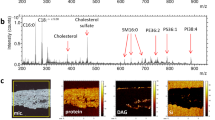Abstract
Mass spectrometry imaging (MSI) was applied to samples from mouse skin and from a human in vitro 3D skin model in order to assess its suitability in the context of photosafety evaluation. MSI proved to be a suitable method for the detection of the model compound sparfloxacin in biological tissues following systemic administration (oral gavage, 100 mg/kg) and subsequent exposure to simulated sunlight. In the human in vitro 3D skin model, a concentration-dependent increase as well as an irradiation-dependent decrease of sparfloxacin was observed. The MSI data on samples from mouse skin showed high signals of sparfloxacin 8 h after dosing. In contrast, animals irradiated with simulated sunlight showed significantly lower signals for sparfloxacin starting already at 1 h postirradiation, with no measurable intensity at the later time points (3 h and 6 h), suggesting a time- and irradiation-dependent degradation of sparfloxacin. The acquisition resolution of 100 μm proved to be adequate for the visualization of the distribution of sparfloxacin in the gross ear tissue samples, but distinct skin compartments were unable to be resolved. The label-free detection of intact sparfloxacin was only the first step in an attempt to gain a deeper understanding of the phototoxic processes. Further work is needed to identify the degradation products of sparfloxacin implicated in the observed inflammatory processes in order to better understand the origin and the mechanism of the phototoxic reaction.

ᅟ





Similar content being viewed by others
References
Drucker, A.M., Rosen, C.F.: Drug-induced photosensitivity. Drug Saf. 34, 821–837 (2011)
Ferguson, J.: Photosensitivity due to drugs. Photodermatol. Photoimmunol. Photomed. 18, 262–269 (2002)
Moore, E.M.: Drug-induced cutaneous photosensitivity. Drug Saf. 25, 345–372 (2002)
Caprioli, R.M., Farmer, T.B., Gile, J.: Molecular imaging of biological samples: localization of peptides and proteins using MALDI-TOF MS. Anal. Chem. 69, 4751–4760 (1997)
Stoeckli, M., Staab, D., Schweitzer, A.: Imaging of a beta-peptide distribution in whole-body mice sections by MALDI mass spectrometry. Int. J. Mass Spectrom. 260, 195–202 (2007)
Rohner, T.C., Staab, D., Stoeckli, M.: MALDI mass spectrometric imaging of biological tissue sections. Mech. Ageing Dev. 126, 177–185 (2005)
Trim, P.J., Henson, C.M., Avery, J.L., McEwan, A., Snel, M.F., Claude, E., Marshall, P.S., West, A., Princivalle, A.P., Clench, M.R.: Matrix-assisted laser desorption/ionization-ion mobility separation-mass spectrometry imaging of vinblastine in whole body tissue sections. Anal. Chem. 80, 8628–8634 (2008)
Prideaux, B., Dartois, V., Staab, D., Weiner, D.M., Goh, A., Via, L.E., Barry III, C.E., Stoeckli, M.: High-sensitivity MALDI-MRM-MS imaging of moxifloxacin distribution in tuberculosis-infected rabbit lungs and granulomatous lesions. Anal. Chem. 83(6), 2112–2118 (2011)
Pierfitte, C., Royer, R.J., Moore, N., Bégaud, B.: The link between sunshine and phototoxicity of sparfloxacin. Br. J. Clin. Pharmacol. 49(6), 609–612 (2000)
Engler, M., Rüsing, G., Sörgel, F., Holzgrabe, U.: Defluorinated sparfloxacin as a new photoproduct identified by liquid chromatography coupled with UV detection and tandem mass spectrometry. Antimicrob. Agents Chemother. 42(5), 1151–1159 (1998)
Hubicka, U., Żuromska-Witek, B., Żmudzki, P., Maślanka, A., Kwapińska, N., Krzek, J.: Determination of sparfloxacin and its photodegradation products by thin-layer chromatography with densitometry detection. Kinetic evaluation of the degradation process and identification of photoproduct by mass spectrometry. Anal. Methods 5, 6734–6740 (2013)
Ackermann, K., Lombardi Borgia, S., Korting, H.C., Mewes, K.R., Schäfer-Korting, M.: The Phenion full-thickness skin model for percutaneous absorption testing. Skin Pharmacol. Physiol. 23, 105–112 (2010)
Boudon, S.M., Plappert, U., Odermatt, A., Bauer, D.: Characterization of vemurafenib phototoxicity in a mouse model. Toxicol. Sci. 137(1), 259–267 (2014)
Schümann, J., Boudon, S., Loll, N., Garcia, D., Schaffner, R., Streich, J., Ulrich, P., Kittel, B., Bauer, D.: Integrated preclinical photosafety testing strategy for systemically applied pharmaceuticals. Toxicol. Sci. 139(1), 245–256 (2014)
Acknowledgments
The authors thank Mr. Martin Schneider and Dr. Ulla Plappert-Helbig for their expertise and support with the animal experiments; Dr. Hans-Joerg Martus and Dr. Willi Suter for their scientific support (all Novartis Pharma AG).
This work was supported by Novartis Institute for BioMedical Research, Novartis Pharma AG, Switzerland. The authors are grateful for the support by COST action BM1104.
Author information
Authors and Affiliations
Corresponding author
Rights and permissions
About this article
Cite this article
Boudon, S.M., Morandi, G., Prideaux, B. et al. Evaluation of Sparfloxacin Distribution by Mass Spectrometry Imaging in a Phototoxicity Model. J. Am. Soc. Mass Spectrom. 25, 1803–1809 (2014). https://doi.org/10.1007/s13361-014-0947-3
Received:
Revised:
Accepted:
Published:
Issue Date:
DOI: https://doi.org/10.1007/s13361-014-0947-3




